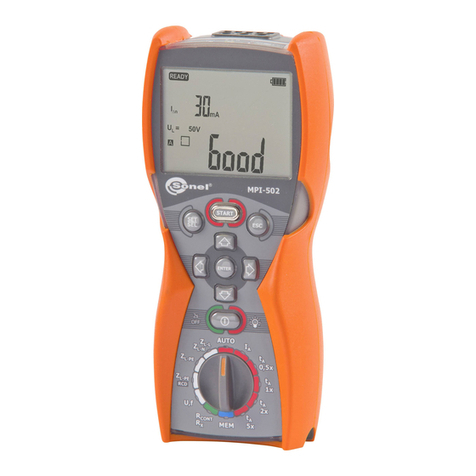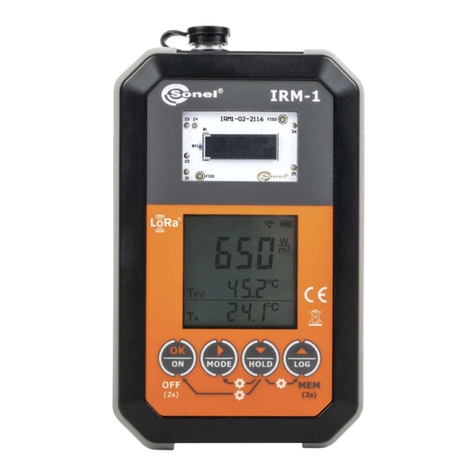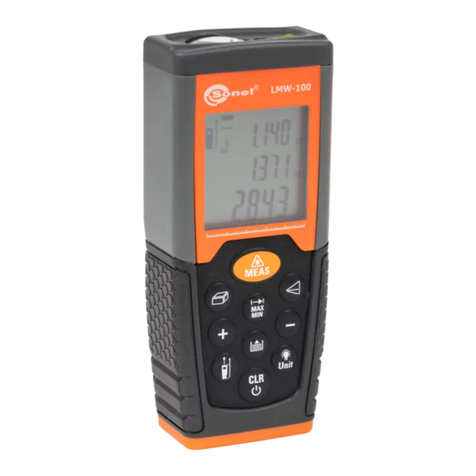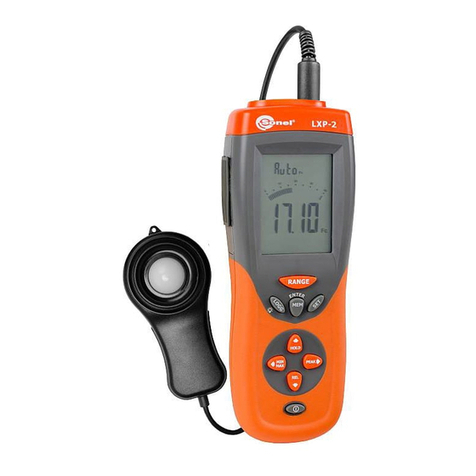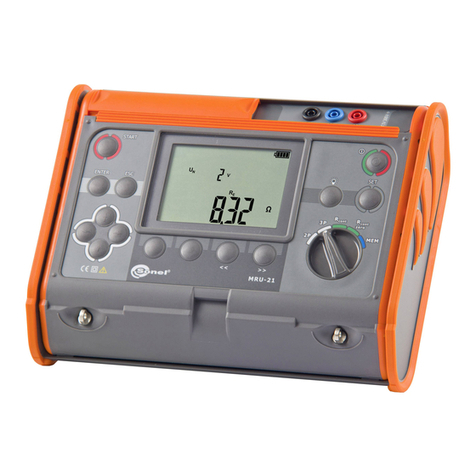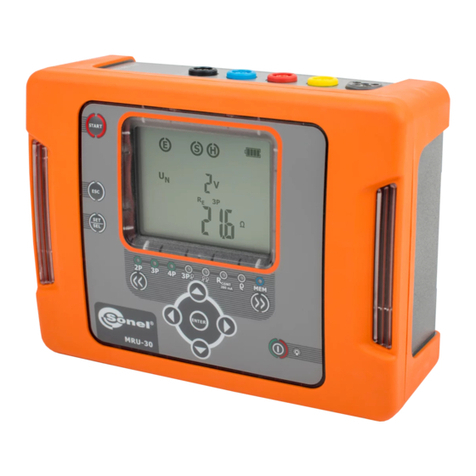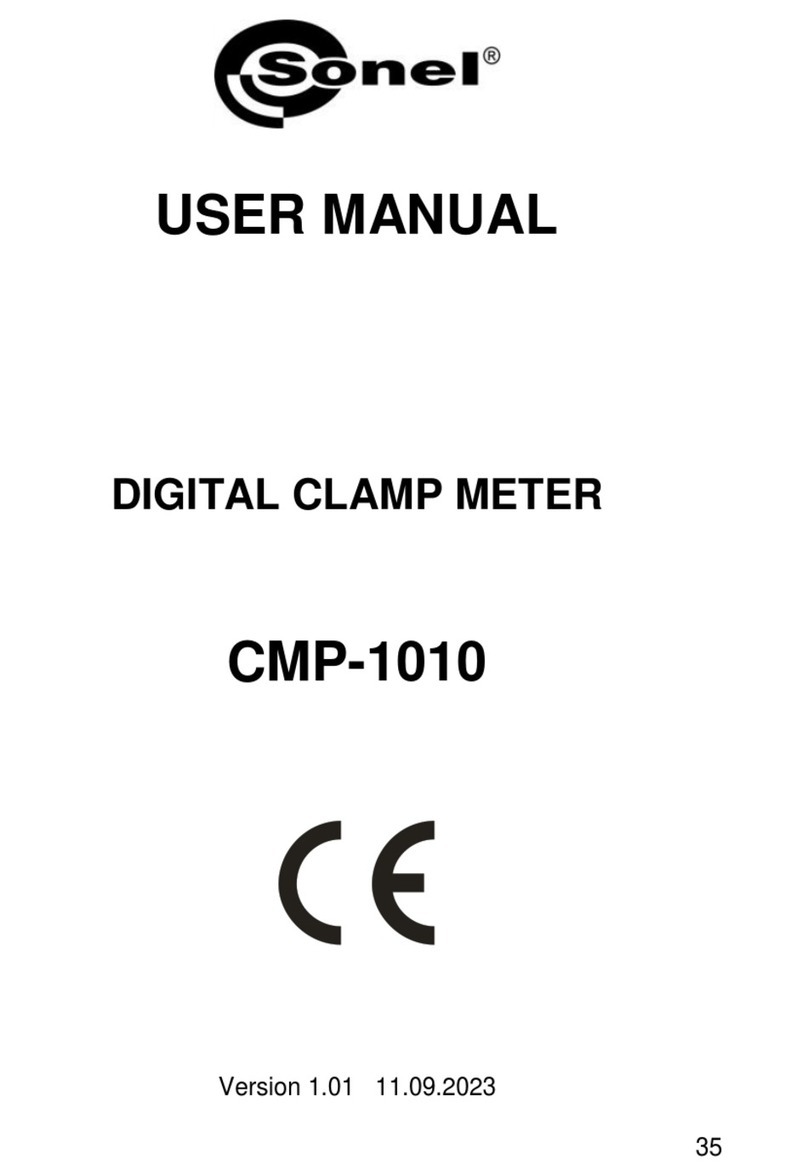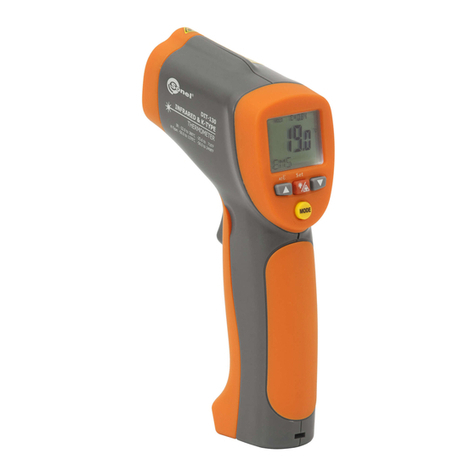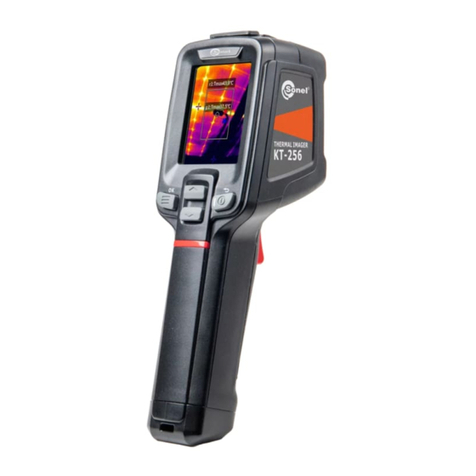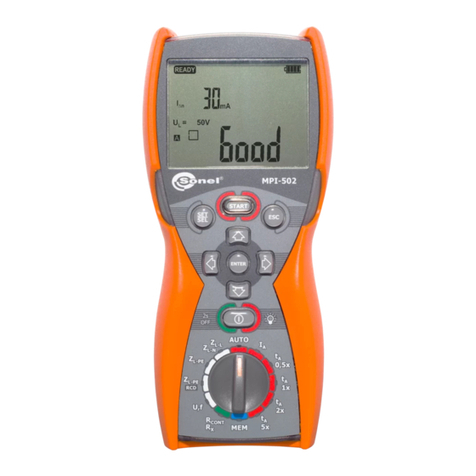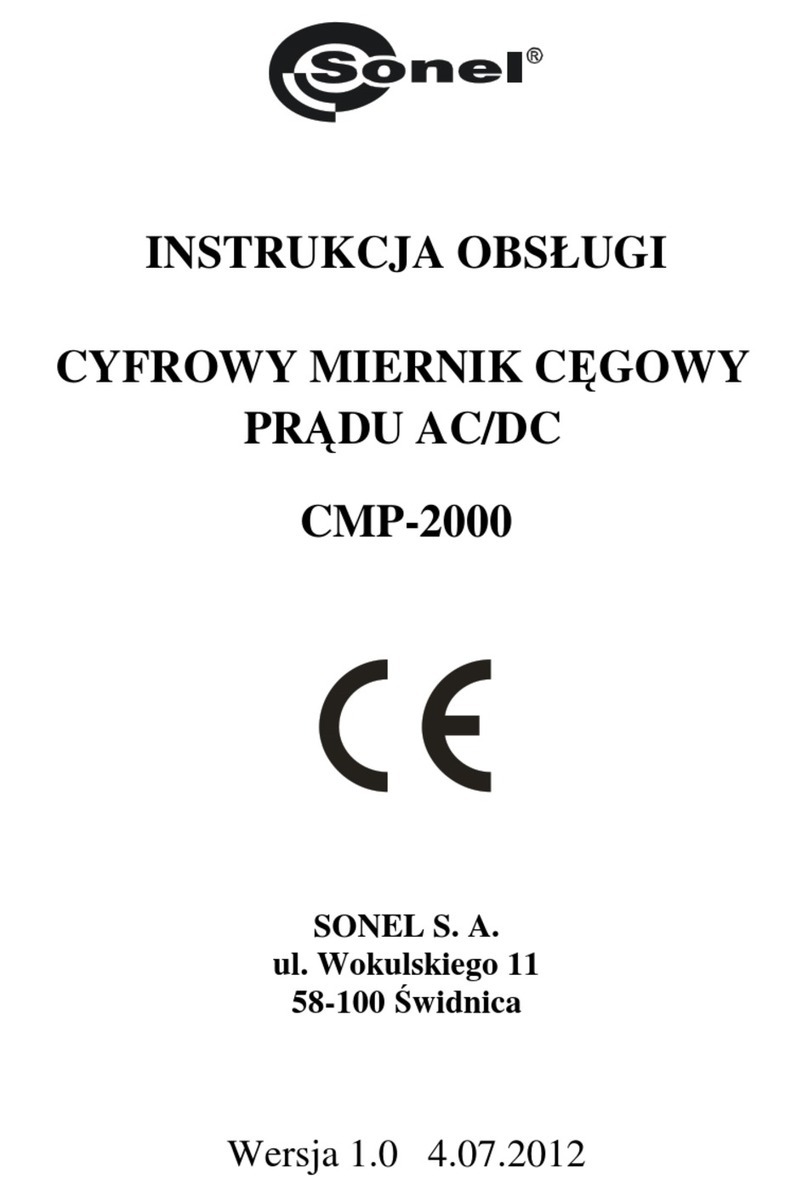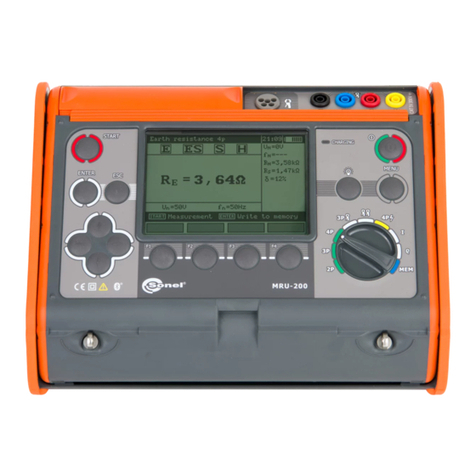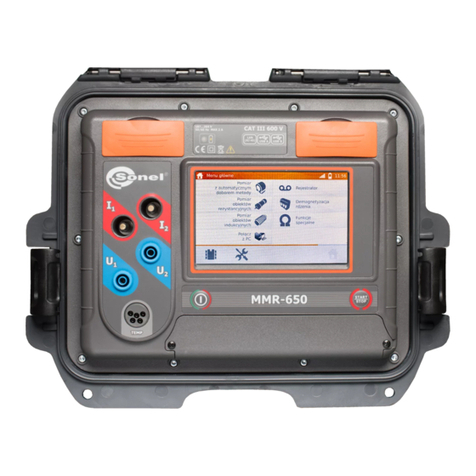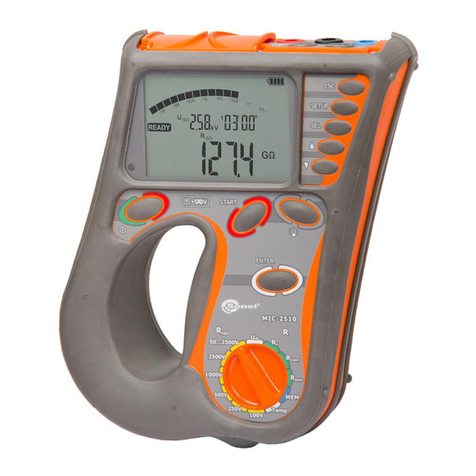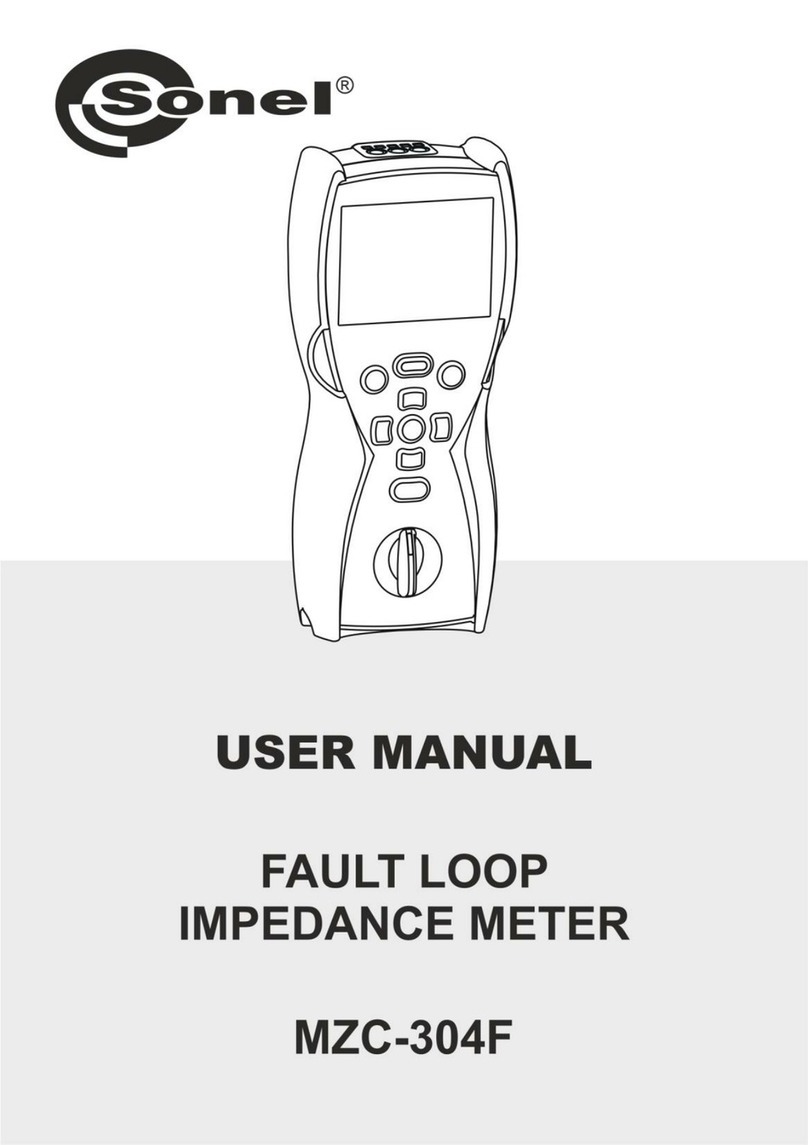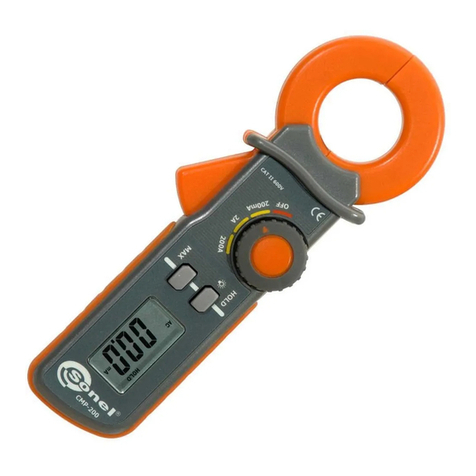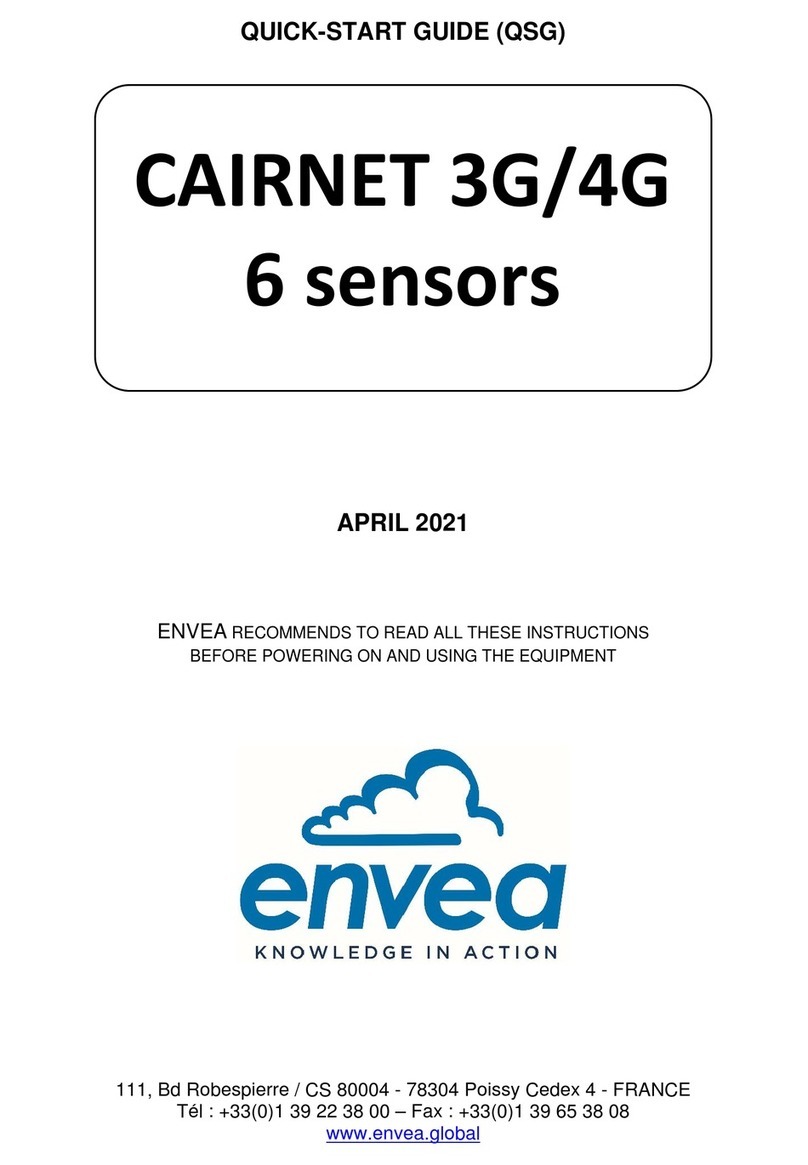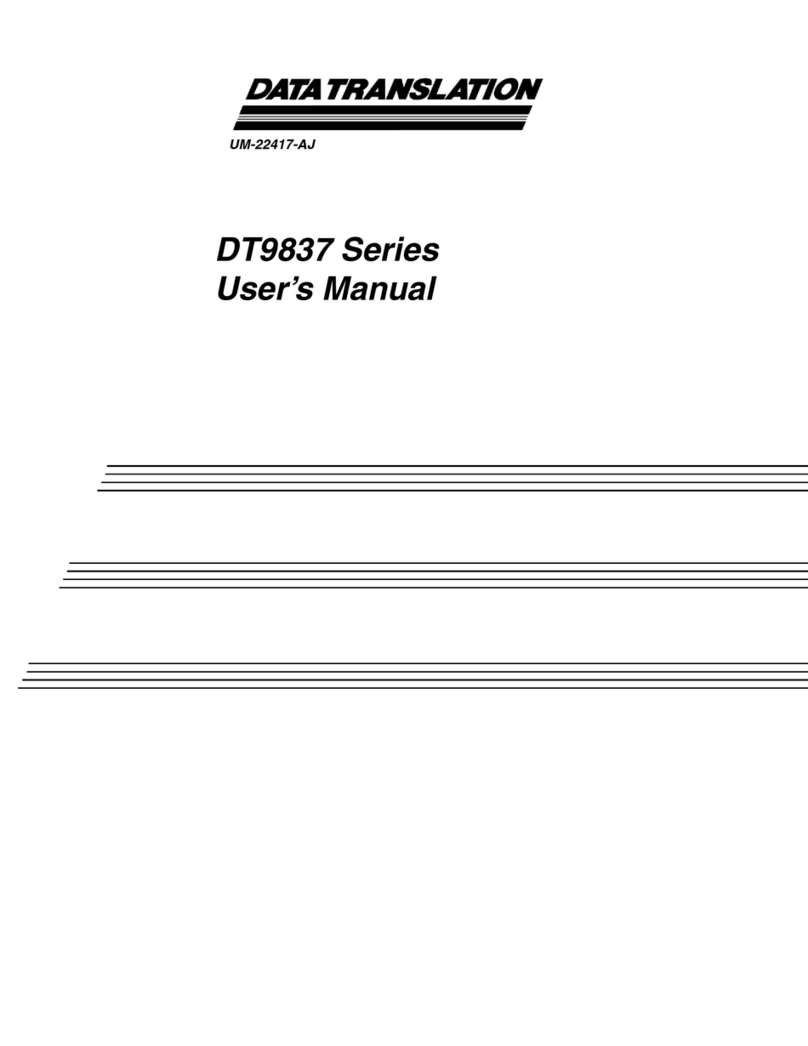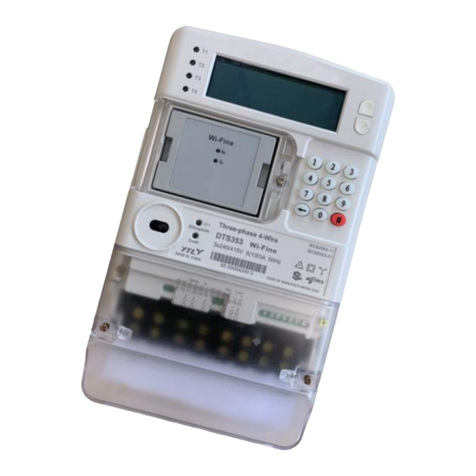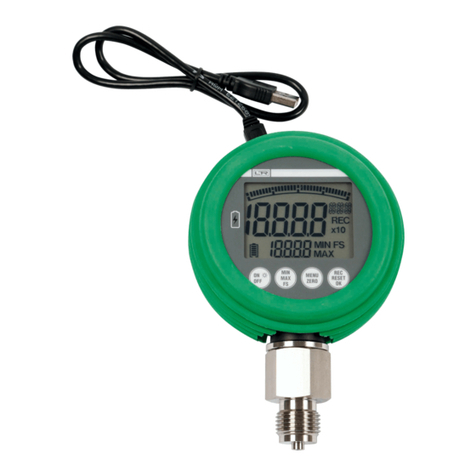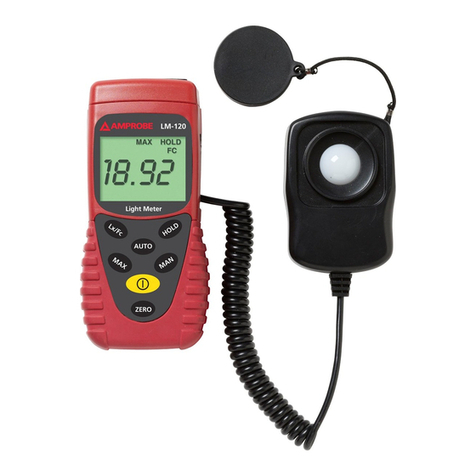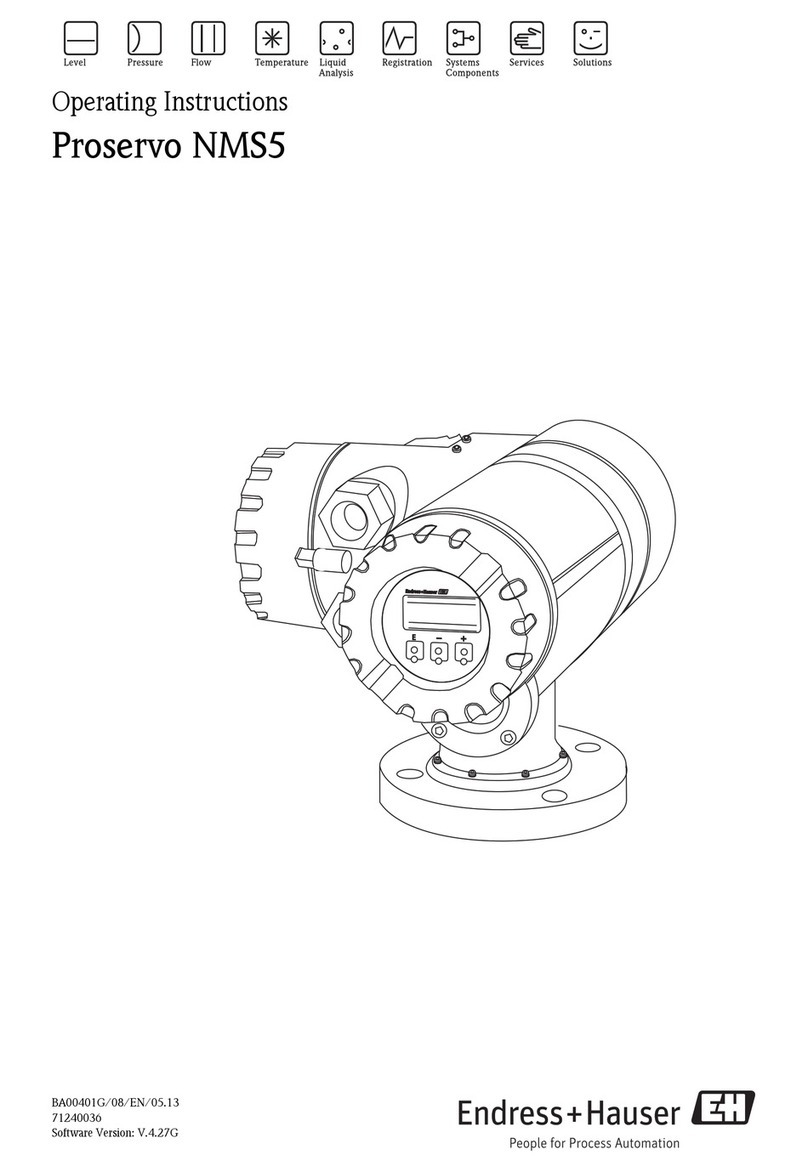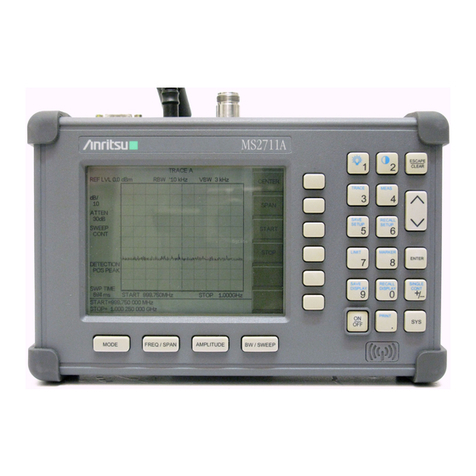Sonel PQM-702 User manual

USER MANUAL
POWER QUALITY ANALYZERS
PQM-702
PQM-702T
PQM-703
PQM-710
PQM-711
SONEL SA
Wokulskiego 11 St.
58-100 Świdnica, Poland
Version 1.25 12.12.2017

Due to continuous product development, the manufacturer reserves the right to make changes
to functionality, features and technical parameters of the analyzers. This manual describes the firm-
ware version 1.25 and the Sonel Analysis v4.1.0 software.

3
CONTENTS
1General Information ............................................................................... 7
1.1 Safety.............................................................................................................8
1.2 General characteristics...................................................................................9
1.3Power supply of the analyzer........................................................................12
1.4 Tightness and outdoor operation..................................................................13
1.5 Mounting on DIN rail.....................................................................................14
1.6 Measured parameters ..................................................................................14
1.7 Compliance with standards ..........................................................................18
2Operation of the analyzer .................................................................... 19
2.1 Buttons.........................................................................................................19
2.2 Switching the analyzer ON/OFF...................................................................19
2.3 Auto-off.........................................................................................................19
2.4 Screens ........................................................................................................20
2.5 Verifying the connection...............................................................................25
2.6 "Sonel Analysis" software.............................................................................25
2.7 PC connection and data transmission..........................................................26
2.7.1 USB communication ...........................................................................................27
2.7.2 Radio communication via OR-1 ..............................................27
2.7.3 Communication via GSM network.......................................................................28
2.7.4 Radio communication via Wi-Fi ..............................................28
2.8 Taking measurements..................................................................................29
2.8.1 Measurement Points...........................................................................................29
2.8.2 Start / stop of recording.......................................................................................30
2.8.3 Recording configuration......................................................................................30
2.8.4 Approximate recording times ..............................................................................32
2.9 Measuring circuits.........................................................................................33
2.10 Example of use.............................................................................................39
2.11 Time Synchronization...................................................................................44
2.11.1 Requirements of IEC 61000-4-30........................................................................44
2.11.2 GPS receiver ......................................................................................................44
2.11.3 Data flagging concept.........................................................................................44
2.11.4 Time resynchronization.......................................................................................45
2.12 GSM communication mode ..........................................................................45
2.12.1 General information about GSM connection........................................................45
2.12.2 Modem Configuration..........................................................................................46
2.12.3 Checking GSM connection..................................................................................48
2.12.4 Possible problems with GSM settings and troubleshooting .................................48
2.13 Wi-Fi communication mode ................................................49
2.13.1 General Information............................................................................................49
2.13.2 Factory configuration ..........................................................................................52
2.13.3 Enabling / disabling / configuring the Wi-Fi access point in the tablet..................52
2.13.4 Configuring Wi-Fi connection via USB connection...............................................54
2.13.5 Editing the Wi-Fi settings in the analyzer database in the absence of USB
connection..........................................................................................................56
2.13.6 Checking Wi-Fi connection .................................................................................57
2.13.7 Possible problems with Wi-Fi settings and troubleshooting.................................57
2.13.8 Transferring data from the tablet to a desktop computer .....................................59

4
2.14 Notification of analyzer changed location.....................................................60
2.15 Key lock........................................................................................................61
2.16 Sleep mode ..................................................................................................61
2.17 Temperature protection................................................................................61
2.18 Emergency time setting................................................................................61
3Design and measurement methods.................................................... 63
3.1 Voltage inputs...............................................................................................63
3.2 Current inputs...............................................................................................63
3.3 Digital integrator ...........................................................................................63
3.4 Signal sampling............................................................................................64
3.5 PLL synchronization.....................................................................................64
3.6 Frequency measurement..............................................................................65
3.7 The method for measuring harmonics..........................................................65
3.8 The method for measuring interharmonics...................................................66
3.9 Measurement of ripple control signals..........................................................67
3.10 Measurement of transients .................................................67
3.10.1 Threshold method...............................................................................................69
3.10.2 Slew rate (dV/dt) method ....................................................................................69
3.11 Current limiting function................................................................................69
3.12 Event detection.............................................................................................70
3.13 Methods of parameter‘s averaging ...............................................................72
4Calculation formulas............................................................................ 73
4.1 One-phase network......................................................................................73
4.2 Split-phase network......................................................................................76
4.3 3-phase wye network with N conductor (3-phase, 4-wire)............................78
4.4 3-phase wye without N conductor and delta networks..................................80
5Power quality - a guide ........................................................................ 82
5.1 Basic information..........................................................................................82
5.1.1 Current Transformer (CT) probes for measuring alternating currents (AC)..........82
5.1.2 Probes for measuring alternating and direct currents (AC/DC)............................83
5.1.3 Flexible probes ...................................................................................................84
5.2 Flicker...........................................................................................................84
5.3 Power measurement ....................................................................................85
5.3.1 Active power.......................................................................................................85
5.3.2 Reactive power...................................................................................................86
5.3.3 Reactive power and three-wire systems..............................................................89
5.3.4 Reactive power and reactive energy meters .......................................................90
5.3.5 Apparent power ..................................................................................................91
5.3.6 Distortion power DBand effective apparent power SeN ........................................92
5.3.7 Power Factor......................................................................................................93
5.4 Harmonics ....................................................................................................93
5.4.1 Harmonics active power......................................................................................95
5.4.2 Harmonics reactive power...................................................................................96
5.4.3 Harmonics in three-phase systems.....................................................................96
5.4.4 Total Harmonic Distortion....................................................................................97
5.4.5 K-Factor..............................................................................................................98
5.5 Interharmonics..............................................................................................98

5
5.5.1 Total Interharmonic Distortion.............................................................................99
5.6 Mains signalling..........................................................................................100
5.7 Unbalance ..................................................................................................101
5.8 Voltage dips, swells and interruptions ........................................................103
5.9 Transients and overvoltages.......................................................................105
5.10 CBEMA and ANSI curves...........................................................................107
5.11 Averaging the measurement results...........................................................109
6Technical data..................................................................................... 112
6.1 Inputs..........................................................................................................112
6.2 Sampling and RTC.....................................................................................113
6.3 Transient module ..............................................................113
6.4 Measured parameters - accuracy, resolution and ranges...........................113
6.4.1 Reference conditions........................................................................................113
6.4.2 The measurement uncertainty due to ambient temperature ..............................113
6.4.3 Voltage.............................................................................................................114
6.4.4 Current .............................................................................................................114
6.4.5 Frequency.........................................................................................................115
6.4.6 Harmonics ........................................................................................................115
6.4.7 Interharmonics..................................................................................................116
6.4.8 Harmonic Powers .............................................................................................116
6.4.9 Power and energy.............................................................................................116
6.4.10 Estimating measurement uncertainty values for power and energy...................117
6.4.11 Flicker...............................................................................................................119
6.4.12 Unbalance ........................................................................................................119
6.4.13 Mains signalling................................................................................................119
6.4.14 Transients ............................................................................119
6.4.15 External temperature .........................................................................119
6.5 Event detection - voltage and current RMS................................................120
6.6 Event detection - other parameters ............................................................120
6.6.1 Event detection hysteresis................................................................................121
6.7 Recording...................................................................................................121
6.8 Power supply, battery, heater.....................................................................123
6.9 Supported networks....................................................................................124
6.10 Supported current probes...........................................................................124
6.11 Communication...........................................................................................124
6.12 Environmental conditions and other technical data ....................................125
6.13 Safety and electromagnetic compatibility ...................................................125
6.14 Standards...................................................................................................126
7Equipment........................................................................................... 127
7.1 Standard equipment (non-US model versions)...........................................127
7.2 Standard equipment (US model versions)..................................................127
7.3 Optional accessories..................................................................................128
7.3.1 C-4(A) current probe.........................................................................................128
7.3.2 C-5(A) current probe.........................................................................................130
7.3.3 C-6(A) current probe.........................................................................................132
7.3.4 C-7(A) current probe.........................................................................................133
7.3.5 F-1(A), F-2(A), F-3(A) current probes................................................................134
7.3.6 External active GPS antenna............................................................................136

6
8Other Information ............................................................................... 137
8.1 Cleaning and maintenance.........................................................................137
8.2 Storage.......................................................................................................137
8.3 Dismantling and utilization..........................................................................137
8.4 Manufacturer ..............................................................................................137

1 General Information
7
1 General Information
The following international symbols are used on the analyzer and in this manual:
Warning;
See explanation in
manual
Functional earth terminal
Alternating voltage/
current
Direct voltage/
current
Double Insulation
(Protection Class)
Conforms to relevant
European Union direc-
tives (Conformité
Européenne)
Do no dispose of
this product as un-
sorted
municipal waste
Recycling information
Conforms to relevant
Australian standards
UL/cUL Safety Certification Mark
The PQM-710 (US model) and PQM-711 (US model) analyzers have been investigated and cer-
tified by Underwriters Laboratories (UL) in accordance with the following Standards:
UL 61010-1, 3rd Edition, May 11, 2012, Revised July 15 2015,
IEC 61010-2-030: 2010 (First Edition),
UL 61010-2-030: 2012 (First Edition),
CAN/CSA-C22.2 No. 61010-1-12, 3rd Edition, Revision dated July 2015,
CAN/CSA-C22.2 No. 61010-2-030-12 (First Edition).
They are UL/cUL listed under the UL File: E490376.
The letter “U” is used throughout this manual for voltage parameters description. This is also
the letter used on the analyzer’s display when “English” language is selected. Alternatively, the
“English (US)” can be selected and the “V” letter is used instead.
The icon with the analyzer name is placed next to sections of the
text that refer to specific features of the analyzer, particularly to availabil-
ity/unavailability of a given function.
All other parts of the text relate to all types of the analyzer.

PQM-702(T), PQM-703, PQM-710, PQM-711 User Manual
8
1.1 Safety
Warning
To avoid electric shock or fire, you must observe the following guidelines:
Before you proceed to operate the analyzer, acquaint yourself thoroughly with the pre-
sent manual and observe the safety regulations and specifications provided by the pro-
ducer.
Any application that differs from those specified in the present manual may result in
damage to the device and constitute a source of danger for the user.
Analyzers must be operated only by appropriately qualified personnel with relevant cer-
tificates authorizing the personnel to perform works on electric systems. Operating the
analyzer by unauthorized personnel may result in damage to the device and constitute a
source of danger for the user.
The device must not be used for networks and devices in areas with special conditions,
e.g. fire-risk and explosive-risk areas.
Before starting the work, check the analyzer, wires, current probes and other accesso-
ries for any sign of mechanical damage. Pay special attention to the connectors.
It is unacceptable to operate the device when:
it is damaged and completely or partially out of order,
its cords and cables have damaged insulation,
of the device and accessories mechanically damaged.
Do not power the analyzer from sources other than those listed in this manual.
Do not connect inputs of the analyzer to voltages higher than the rated values.
Use accessories and probes with a suitable rating and measuring category for the tested
circuit.
Do not exceed the rated parameters of the lowest measurement category (CAT) of the
used measurement set consisting of the analyzer, probes and accessories. The meas-
urement categoryof the entire set is the same as of the component with the lowest meas-
urement category.
If possible, connect the analyzer to the de-energized circuits.
Use the PE (earth) terminal only for connecting the local ground, do not connect it to any
voltage.
Opening the device socket plugs results in the loss of its tightness, leading to a possible
damage in adverse weather conditions. It may also expose the user to the risk of electric
shock.
Do not handle or move the device while holding it only by its cables.
Do not unscrew the nuts from the cable glands, as they are permanently fixed. Unscrew-
ing the nuts will void the guarantee.
It is not allowed to mount ST-2 temperature probe on objects with voltage
higher than 50 V to earth. It is advisable to ground the examined object before mounting
the probe.
Repairs may be performed only by an authorized service point.
The analyzer is equipped with an internal Li-Ion battery, which has been tested by an inde-
pendent laboratory and is quality-certifiedfor compliance with the standard UN Manual of Tests and
Criteria Part III Subsection 38.3 (ST/SG/AC.10/11/Rev.5). Therefore, the analyzer is approved for
air, maritime and road transport.

1 General Information
9
1.2 General characteristics
Power Quality Analyzers PQM-702(T), PQM-703, PQM-710 and PQM-711 (Fig. 1) are high-
tech devices providing their users with a comprehensive features for measuring, analyzing and re-
cording parameters of 50/60 Hz power networks and power quality in accordance with the European
Standard EN 50160. Analyzers are fully compliant with the requirements of IEC 61000-4-30:2008,
Class A.
The device is equipped with five voltage measurement inputs installed as cables terminated
with banana plugs marked as L1/A, L2/B, L3/C, Nand PE (ground). The range of voltages measured
by four measurement channels is up to ±1500V (the device has two voltage sub-ranges). This range
may be increased by using additional external voltage transformers.
Measurements are carried out using four current inputs installed on short cables terminated
with probe terminals. The terminals may be connected to the following probe types: flexible claps
(marked as F-1(A), F-2(A), F-3(A)) with nominal rating up to 3000 A (differing from others only by
coil diameter); and hard probes marked as C-4 (range up to 1000 A AC), C-5(A) (up to 1000 A
AC/DC), C-6(A) (up to 10 A AC) and C-7(A) (up to 100 A AC). The values of nominal measured
currents may be changed by using additional transducers –for example, using a transducer of
1000:5 ratio, the user may select C-6(A) probes to measure currents up to 1000 A.
The device has a built-in 8 GB memory card. To guarantee fast data read-out, the analyzer is
equipped with a built-inmass-storage reader, which ensures thedata readout with a fewMB/s. Data
read-out may be also be carried out by one of the three available communication links: USB, OR-1
radio receiver, and GSM modem.
The device is provided with a built-in GSM modem (UMTS standard) and an antenna. This
solution provides it with almost unrestricted access to the analyzer from any chosen global location
with available GSM network. On the left side of its housing the analyzer has a SIM card, which is
required for data transmission via GSM networks.
Another advantage of the device is a built-in GPS receiver with antenna, making the analyzer
fully compliant with the requirements of IEC 61000-4-30 Class A, without the need of installing ad-
ditional accessories. The GPS receiver ensures the synchronization with UTC (Universal Time
Clock), and provides measurement accuracy of tens of nanoseconds. GPS receivers may receive
satellite signals in the open air; therefore synchronization with a built-in antenna is possible only
outside of buildings. When the analyzer is used indoors, in order to ensure the availability of the
GPS signal, the device should be connected to an external GPS antenna (cable length: 10m) lo-
cated outside the building. External antenna is an additional accessory.
Tab. 1. Main differences between analyzers
PQM-702
PQM-702T
PQM-703
PQM-710
PQM-711
Transient module
433 MHz radio interface
(with OR-1 receiver)
Wi-Fi radio interface
Dedicated tablet as standard
equipment
External temperature measure-
ment (with ST-2 probe)

PQM-702(T), PQM-703, PQM-710, PQM-711 User Manual
10
Fig. 1. Power Quality Analyzer. General view.
Recorded parameters are divided into groups that may be independently turned on/off for re-
cording purposes and this solution facilitates the rational management of the space on the memory
card. Parameters that are not recorded, leave more memory space for further measurements.
PQM-702T power supply quality analyzer is a variant of PQM-702 analyzer and it addi-
tionally enables measurements of the temperature of external objects with ST-2 probe (standard
accessory). Other capabilities and functions of PQM-702T analyzer are the same as in PQM-702.
The terminal for connecting the probe is in the pass together with current probe terminals and
it is marked with the letter "T".
Unless stated otherwise, in the following part of the manual, all sections referring to PQM-702
analyzer also apply to PQM-702T.
The analyzer has an internal power supply adapter operating in a wide input voltage range
100…690 V AC (140…690 V DC), which is provided with independent cables terminated with ba-
nana plugs.
An important feature of the device is its ability to operate in harsh weather conditions - the
analyzer may be installed directly on electric poles. The ingress protection class of the analyzer is
IP 65, and operating temperature ranges from -20°C to +55°C.
Uninterrupted operation of the device (in case of power failure) is ensured by an internal re-
chargeable lithium-ion battery.

1 General Information
11
The user interface includes a color 3.5" LCD display with a resolution of 320x240 pixels and a
keypad with four buttons.
The full potential of the device may be released by using dedicated PC software "Sonel Analy-
sis".
The analyzer may communicate with a PC in the following ways:
via USB connection with a transmission speed up to 921.6 kbit/s; available data reading from
a memory card with a speed of a few MB/s,
via radio interface –using OR-1 receiver with a transmission rate of 57.6
kbit/s (range limited to approx. 5 m),
via Wi-Fi radio interface with effective transmission rate up to 300 kB/s
(max. sustained speed in a 10 m distance),
via GSM connection using the Internet.
In order to use the first mode of wireless communication, OR-1 receiver must
be connected to a PC using its USB port. Communication in this mode is slower, therefore we
recommend it to view current (live) parameters of the measured network and to configure and con-
trol the analyzer. It is not recommended to read a large amount of data stored on the memory card
via a radio link, due to the slower data transmission.
Fig. 2. The rear wall of the analyzer.

PQM-702(T), PQM-703, PQM-710, PQM-711 User Manual
12
The analyzer is supplied with a dedicated tablet, which is pre-configured to
work with the meter. After the tablet is turned on, it activates Sonel Analysis software, which auto-
matically finds assigned to the analyzer. The tablet acts as an Access Point, which is used to con-
nect the analyzer through wireless transmission (Wi-Fi). More information about the Wi-Fi setup and
possible transmission modes is presented in the manual of Sonel Analysis software and in sec.
2.7.4.
GSM network transmission requires an active user's SIM card to be inserted into the slot of
the analyzer. The card should have the service of data transmission activated and a static IP num-
ber. A PC connected to the analyzer, must have the Internet access.
Compared to PQM-702 and PQM-710 models, PQM-703 and PQM-711 an-
alyzers additionally enables the user to measure transient voltages in the range of ±8 kV with sam-
pling rate from 100 kHz to 10 MHz. Measuring circuits for transients are independent from the rest
of voltage circuits and connected to voltage inputs L1/A, L2/B, L3/C, N, PE. The analyzers have
four measurement channels: L1/A-PE, L2/B-PE, L3/C-PE and N-PE. Recording time waveforms is
done with user-defined pretrigger time and detection threshold, while the number of recorded sam-
ples is up to 20000 per channel (2 ms for 10 MHz sampling).
1.3 Power supply of the analyzer
The analyzer has a built-in power adapter with nominal voltage range of 100…690 V AC or
140…690 V DC (90…760 V AC or 127…760 V DC including fluctuations). The power adapter has
independent lines (red) marked with letter P (power). To prevent the power adapter from being
damaged by undervoltage, it automatically switches off when powered with input voltages below
approx. 80 V AC (110 V DC).
To maintain power supply to the device duringpower outages, the internal rechargeable battery
is used. It is charged when the voltage is present at terminals of the AC adapter. The battery is able
to maintain power supply up to 2 h hours at temperatures of -20...+55°C. After the battery is dis-
charged the meter stops its current operations (e.g. recording) and switches off in the emergency
mode. When the power supply from mains returns, the analyzer resumes interrupted recording.
Note
The battery may be replaced only by the manufacturer's service de-
partment.

1 General Information
13
1.4 Tightness and outdoor operation
The analyzer is designed to work in difficult weather conditions - it can be installed directly on
electric poles. Two bands with buckles and two plastic fasteners are used for mounting the analyzer.
The fasteners are screwed to the back wall of the housing, and bands should be passed through
the resulting gaps.
The ingress protection class of the analyzer is IP 65, and operating temperature ranges from
-20°C to +55°C.
At ambient temperatures below 0C or when the internal temperature drops below this point,
the internal heater of the device is switched on - its task is to keep the internal temperature above
zero, when ambient temperatures range from -20C to 0C.
The heater is powered from the AC/DC power adapter, and its power is limited to approx. 5 W.
Due to the characteristics of the built-in lithium-ion rechargeable battery, the process of
charging is blocked when the battery temperature is outside the range of -10C…60C (in such
case, Sonel Analysis software indicates charging status as "charging suspended").
Fig. 3. Fasteners for bands (for mounting the analyzer on a pole)
Note
In order to ensure the declared ingress protection class IP 65, the
following rules must be observed:
Tightly insert the stoppers in the slots of USB and SIM card,
Unused probe terminals must be sealed with silicone stoppers,
Tighten the plug of the socket used for external GPS antenna (or tightly
screw the external GPS antenna into the socket).

PQM-702(T), PQM-703, PQM-710, PQM-711 User Manual
14
1.5 Mounting on DIN rail
The device is supplied with a bracket for mounting the analyzer on a standard DIN rail. The
bracket must be fixed to the back of the analyzer with the provided screws. The set includes also
positioning catches (in addition to fasteners for mounting the analyzer on a pole), which should be
installed to increase the stability of the mounting assembly. These catches have special hooks that
are supported on the DIN rail.
Fig. 4. The rear wall of the analyzer with fixtures for mounting on DIN rail.
Measured parameters
The analyzer is designed to measure and record the following parameters:
RMS phase and phase-to-phase voltages - up to 760 V (peak voltages up to ±1500 V),
transient voltages (overvoltages) in the range up to ±8 kV,
RMS currents: up to 3000 A (peak currents - up to ±10 kA) using flexible probes (F-1(A), F-2(A),
F-3(A)); up to 1000 A (peak values - up to ±3600 A) using probes (C-4(A) or C-5(A)); up to 10 A
(peak values - up to ±36 A) using C-6(A) probes, or up to 100 A (peak values - up to ±360 A)
using C-7(A) probes,
crest factors for current and voltage,
mains frequency within the range of 40..70 Hz,
active, reactive and apparent power and energy, distortion power,
harmonics of voltages and currents (up to 50th),
Total Harmonic Distortion THDFand THDRfor current and voltage,
K-Factor (factor loss in transformers caused by higher harmonics),
active and reactive powers of harmonics,
the angles between voltage and current harmonics,
power factor, cosφ (DPF), tanφ,
unbalance factors and symmetrical components for three-phase mains,
flicker severity PST and PLT,
interharmonics of voltages and currents (up to 50th),
Total Interharmonic Distortion TIDFand TIDRfor current and voltage,

1 General Information
15
mains signaling voltage in the frequency band of 5...3000 Hz.
Some of the parameters are aggregated (averaged) according to the time selected by the user
and may be stored on a memory card. In addition to average value, it is also possible to record
minimum and maximum values during the averaging period, and to record the instantaneous value
occurring at the end of aggregation period.
The module for event detection is also expanded. According toEN 50160, typical events include
voltage dip (reduction of RMS voltage to less than 90% of nominal voltage), swell (exceeding 110%
of the nominal value) and interruption (reduction of the supplied voltage below 5 % of the nominal
voltage) The user does not have to enter the settings defined in EN 50160, as the software provides
an automatic configuration of the device to obtain power quality measurement mode compliant with
EN 50160 The user may also perform manual configuration - the software is fully flexible in this
area. Voltage is only one of many parameters for which thelimits of event detectionmay be defined.
For example, the analyzer may be configured to detect power factor drop below a defined value,
THD exceeding another threshold, and the 9th voltage harmonic exceeding a user-defined percent-
age value. Each event is recorded along with the time of occurrence. For events that relate to ex-
ceeding the pre-defined limits for voltage dip, swell, interruption, and exceeding minimum and max-
imum current values, the recorded information may also include a waveform for voltage and current.
It is possible to record from 5 mains cycles of up to 1 second, with adjustable pre-triggering time.
Together with the waveform, half-cycle RMS values (RMS1/2) may be also recorded with time ad-
justable from 1 s to 5 s.
Additionally, the analyzer has the ability to detect events caused by the change of the shape of the
voltage envelope and the voltage phase angle, by comparing consecutive successive periods of
the network with each other.
Events caused by changes of the shape of the envelope
In this method, two adjacent periods of voltage waveforms are compared with each other - the
difference between them is calculated and its maximum amplitude is checked, which is then com-
pared with the threshold set by the user. The percentage threshold refers to the nominal voltage
value. An event is considered to be terminated if no exceedance of the tolerance threshold has
been detected for at least three consecutive periods.
This functionality is very helpful in detecting any non-stationary disturbances in the power sup-
ply network. It should be remembered that at low values of the detection threshold, the analyzer
can detect a very large number of events in a short time interval. For this reason, the user has the
"Hold time" parameter that can be set in seconds. After the event is detected, the analyzer blocks
the detection of subsequent events (in a given channel) for the time specified by this parameter. It
can be set in the range from 1s to 600 s.
Note
The analyzers that have a hardware version that is older than HWg,
events from envelope shape change and phase voltage change have a
minimum inbuilt hold time of 2 seconds (for all voltage channels) and it
can not be reduced. The hold time of the envelope change can be in-
creased further in the measurement configuration if necessary.

PQM-702(T), PQM-703, PQM-710, PQM-711 User Manual
16
Phase voltage change events
Checking the "Phase change" box activates the detection of sudden changes in the voltage
waveform phase. The detection algorithm compares the angles of the fundamental voltage compo-
nent of two or three neighboring periods. If the difference in angles is greater than the user-defined
threshold expressed in degrees, information about the detection of the event is recorded along with
the measured value of the phase angle change. The phase changes are most often an effect ac-
companying voltage dips. The change of the impedance of the load in relation to the impedance of
the supply network causes a change in the observed angle of the fundamental components of the
voltage (displacement of the zero crossing points).
A very wide range of configurations, including a multitude of measured parameters make the
analyzer an extremely useful and powerful tool for measuring and analyzing all kinds of power sup-
ply systems and interferences occurring in them. Some of the unique features of this device make
it distinguishable from other similar analyzers available in the market.
Tab. 2 presents a summary of parameters measured by analyzer, dependingon the mainstype.

1 General Information
17
Tab. 2. Measured parameters for different network configurations.
Network type,
channel
Parameter
1-phase
split-phase
3-phase wye with N,
3-phase delta
3-phase wye without N,
L1/A
N
L1/A
L2/B
N
Ʃ
L1/A
L2/B
L3/C
N
Ʃ
L12/AB
L23/BC
L31/CA
Ʃ
U
RMS voltage
UDC
DC voltage
I
RMS current
IDC
DC current
F
Frequency
CF U
Voltage crest factor
CF I
Current crest factor
P
Active power
Q1, QB
Reactive power
(1)
D, SN
Distortion power
S
Apparent power
PF
Power Factor
Cosφ/DPF
Displacement power factor
tanφ
tangent φ factor
(1)
THD U
Voltage total harmonic distor-
tion
THD I
Current total harmonic distor-
tion
K
K-Factor
EP+, EP-
Active energy (consumed and
supplied)
EQ1+, EQ1-
EQB+, EQB-
Reactive energy (consumed
and supplied)
(1)
ES
Apparent energy
Uh1..Uh50
Voltage harmonic amplitudes
Ih1..Ih50
Current harmonic amplitudes
φUI1.. φUI50
Angles between voltage and
current harmonics
Ph1..Ph50
harmonics active power
Qh1..Qh50
harmonics reactive power
Unbalance U,
I
Symmetrical components and
unbalance factors
Pst, Plt
Flicker
TID U
Voltage total interharmonic dis-
tortion
TID I
Current total interharmonic dis-
tortion
Uih0..Uih50
Voltage interharmonics ampli-
tudes
Iih0..Iih50
Current interharmonics ampli-
tudes
UR1, UR2
Mains signalling in voltage
Ut
Voltage transients(2)
Explanations: L1/A, L2/B, L3/C (L12/AB, L23/BC, L31/CA) indicate subsequent phases
N is a measurement for voltage channel N-PE or current channel IN, depending on the parame-
ter type,
Ʃis the total value for the system.
(1) In 3-wire networks, the total reactive power is calculated as inactive power
(see discussion on reactive power in section 5.3)
(2) Voltage transients are measured in channels: L1/A-PE, L2/B-PE, L3/C-PE and N-PE.

PQM-702(T), PQM-703, PQM-710, PQM-711 User Manual
18
1.7 Compliance with standards
The analyzer is designed to meet the requirements of the following standards.
Standards valid for measuring network parameters:
IEC 61000-4-30:2008 –Electromagnetic compatibility (EMC) - Testing and measurement
techniques - Power quality measurement methods,
IEC 61000-4-7:2007 –Electromagnetic compatibility (EMC) –Testing and Measurement
Techniques - General Guide on Harmonics and Interharmonics Measurements and
Instrumentation for Power Supply Systems and Equipment Connected to them,
IEC 61000-4-15:2011 –Electromagnetic compatibility (EMC) –Testing and Measurement
Techniques - Flickermeter - Functional and Design Specifications,
EN 50160:2010 –Voltagecharacteristics of electricity supplied by public distribution networks.
Safety standards:
IEC 61010-1 –Safety requirements for electrical equipment for measurement control and
laboratory use. Part 1: General requirements
Standards for electromagnetic compatibility:
IEC 61326 –Electrical equipment for measurement, control and laboratory use. Requirements
for electromagnetic compatibility (EMC).
The device meets all the requirements of Class A as defined in IEC 61000-4-30. The summary
of the requirements is presented in the table below.
Tab. 3. Summary of selected parameters in terms of their compliance with the standards
Aggregation of measure-
ments at different inter-
vals
IEC 61000-4-30 Class A:
Basic measurement time for parameters (voltage, current, harmonics, unbal-
ance) is a 10-cycle interval for 50 Hz power supply system and 12-cycle inter-
val for 60 Hz system,
Interval of 3 s (150 cycles for the nominal frequency of 50 Hz and 180 cycles
for 60 Hz),
Interval of 10 minutes,
Interval of 2 h (basing on 12 intervals of 10 min.)
Synchronization of aggregation intervals
Real-time clock (RTC)
uncertainty
IEC 61000-4-30 Class A:
Clock synchronization to GPS time using the built-in GPS receiver with inter-
nal or external antenna,
Built-in real time clock, which is set from "Sonel Analysis",
RTC accuracy after GPS signal loss - better than ±0.3 s/day
Frequency
Compliant with IEC 61000-4-30 Class A of the measurement method and uncer-
tainty
Power supply voltage
Compliant with IEC 61000-4-30 Class A of the measurement method and uncer-
tainty
Voltage fluctuations
(flicker)
The measurement method and uncertainty meets the requirements of IEC
61000-4-15 standard.
Dips, interruptions and
surges of supply voltage
Compliant with IEC 61000-4-30 Class A of the measurement method and uncer-
tainty
Supply voltage unbal-
ance
Compliant with IEC 61000-4-30 Class A of the measurement method and uncer-
tainty
Voltage and current har-
monics
Compliant with IEC 61000-4-30 Class A of the measurement method and uncer-
tainty (IEC 61000-4-7 Class I)
Voltage and current
interharmonics
Compliant with IEC 61000-4-30 Class A of the measurement method and uncer-
tainty (IEC 61000-4-7 Class I)
Mains signalling voltage
on the supply voltage
Compliant with IEC 61000-4-30 Class A of the measurement method and uncer-
tainty

2 Operation of the analyzer
19
2 Operation of the analyzer
2.1 Buttons
The keyboard of the analyzer consists of four buttons: ON/OFF , LEFT , RIGHT
, START/STOP . To switch-on the analyzer, press ON/OFF button. Directional buttons
LEFT and RIGHT are used primarily to change the information screens. The screens change circu-
larly, i.e. after pressing RIGHT button, when the last screen is displayed, the device goes to screen
1. After pressing LEFT button, screens are displayed in reverse order. START/STOP button is used
to start and stop the recording as defined in the configuration of current set point.
2.2 Switching the analyzer ON/OFF
The analyzer may be switched-on by briefly pressing button . Then a welcome screen is
displayed, showing the name of the meter, the internal software version (firmware), hardware
version and serial number. Then, the analyzer performs a self-test and in case of detecting
errors, thedisplay shows an error message, accompaniedby a long beep.When an error occurs
during memory card launching, the following message is displayed "Memorycard error". If the
file system on the card is damaged (e.g. when the user manually formatted the card as mass
storage memory accessible only for the user) the analyzer will suggest formatting the memory
(message "Format memory card?") and button will trigger the process of formatting (3
short beeps). After the formatting is completed, the analyzer will repeat initialization of the card.
When during the card initialization, the analyzer detects FIRMWARE.PQF file in the root
directory, which includes a newer version of the firmware (internal software), the upgrade
process will be suggested by the analyzer by displaying message "Update firmware?". Button
triggers this process (3 short beeps) and its progress may be observed on the display.
The update may be skipped by briefly pressing the button . The update is also skipped if
the user does not press any button for 10 sec. When the update is successfully completed,
message "Update successful!”, will be displayed or in other case "Update Failed!”. Then the
analyzer will automatically restart.
After switching on, the analyzer is activated at the last measurement point and displays 1/9
screen with a phasor diagram.
To switch the analyzer OFF, keep button pressed for 2 seconds, when no button or
recording lock are active.
Pressing the active button results in a short beep of a higher pitch; for inactive button the beep
is longer and at a lower pitch.
Pressing button or for at least 1.5 s forces the display to refresh.
2.3 Auto-off
When the analyzer operates for at least 30 minutes powered by the battery (no power supply
from mains) and it is not in the recording mode and PC connection is inactive, the device automat-
ically turns-off to prevent onward discharging of the battery.
The analyzer turns off automatically also when the battery is fully discharged. Such emergency
shut-down is performed regardless of the mode of the device. In case of active recording, it will be
interrupted. When the power supply returns, the recording process is resumed. Emergency shut-
down is signalled by message "Battery discharged!"

PQM-702(T), PQM-703, PQM-710, PQM-711 User Manual
20
2.4 Screens
Fig. 5 presents the first screen displayed by the analyzer. The bar in the upper part is a perma-
nent element, shown independent of the selected screen.
Fig. 5. Screen 1 with a phasor diagram and indicators of connection corectness.
The bar includes (from the left):
onumber of active measurement point (confoguration): P1, P2, P3 or P4. In some modes
measurement point number is displayed alternately with additional graphic symbol:
oThe symbol of sinusoid is displayed when the memory of the measurement point is
completely filled with recorded data, or when the measurement point is not assigned to
any place (zero allocation). In such conditions, recording cannot be started; only viewing
the current values is possible.
oThe symbol of slope with an arrow indicates waiting for triggering the recording pro-
cess by the first detected event (threshold triggering).
oThe hourglass symbol indicates waiting for recording to start in the scheduled record-
ing mode (also between recording intervals).
available space on the memory card for an active measurement point - in MB or GB.
current date and time in the format day.month.year, hour:minute:second. Date and time are
displayed in green, when time of the analyzer is synchronized to GPS time and meets the
requirements for the accuracy specified in IEC 61000-4-30 and valid for analyzers of class A.
If time does not meet these requirements, it is displayed in orange.
indicator of mains power supply or battery status,
indicator of GSM network signal strength (if a SIM card is inserted and connection GSM network
is active).
Screen number is displayed in the lower right corner of the display.
Screen 1is displayed by default after turning the analyzer on and after changing a measurement
point. It presents a phasor diagram of the measured mains and indicators of correct connection to
the mains. This feature is described in chapter 2.5.
Note
Screens count is device dependent. PQM-702 and PQM-703 have 9
screens, whereas PQM-710 and PQM-711 have 10 screens.
Other manuals for PQM-702
2
This manual suits for next models
4
Table of contents
Other Sonel Measuring Instrument manuals
Popular Measuring Instrument manuals by other brands

Trace2O
Trace2O METALYSER DELUXE HM2000 quick start guide
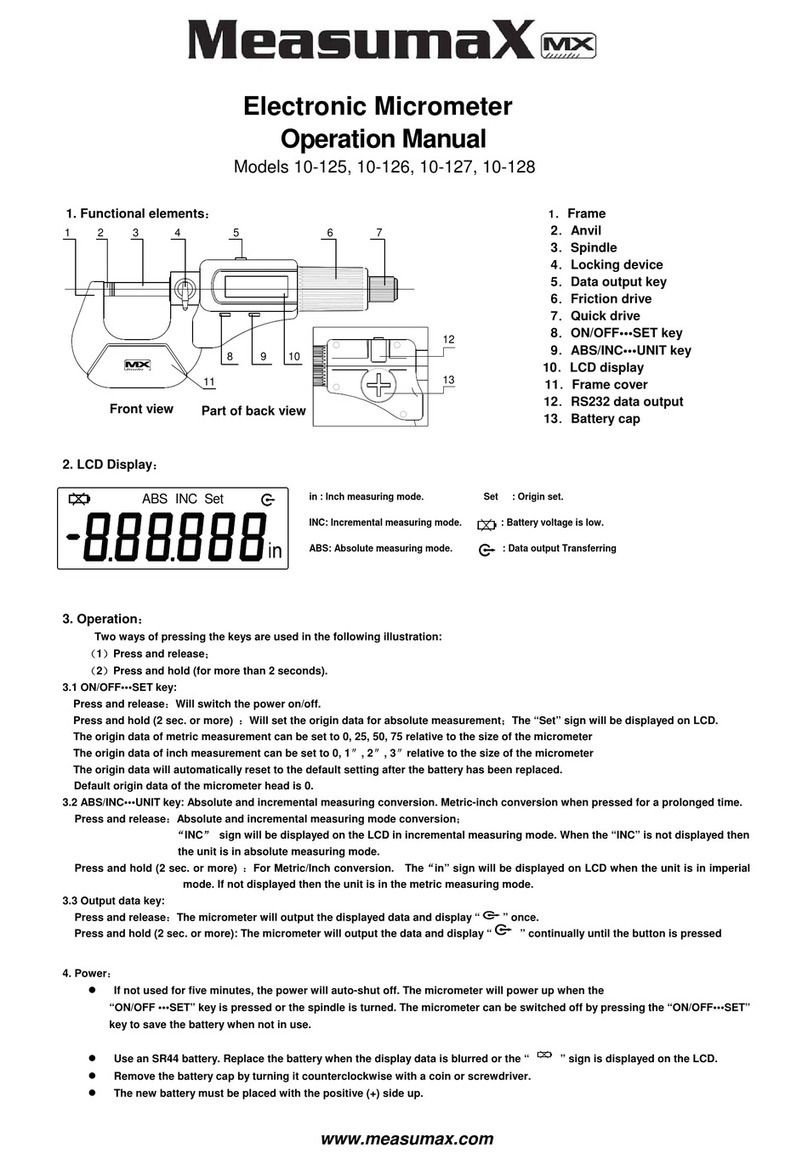
Measumax
Measumax 10-125 Operation manual
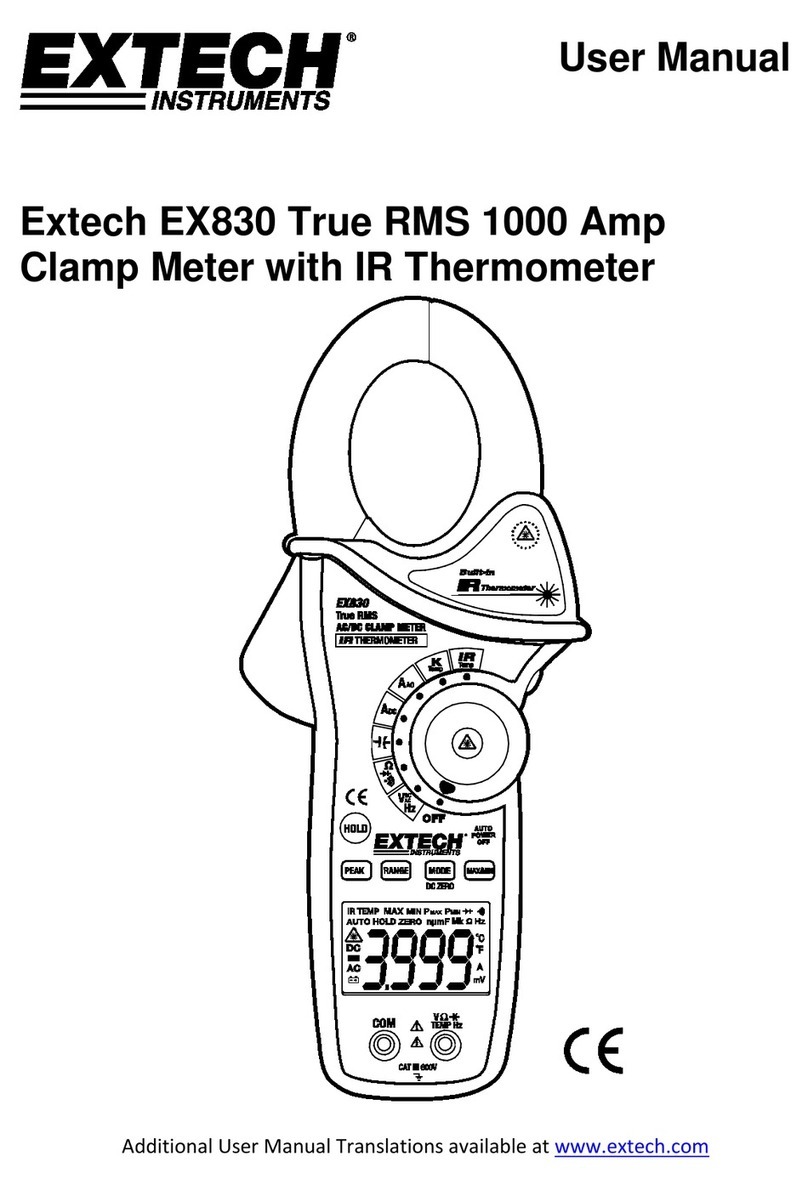
Extech Instruments
Extech Instruments EX830 user manual

WAGNER
WAGNER RAPID RH user manual
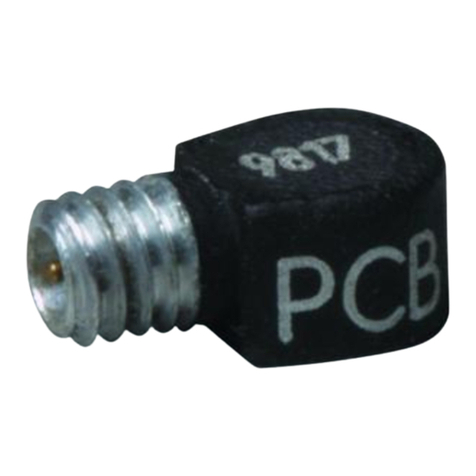
PCB Piezotronics
PCB Piezotronics 357A08 Installation and operating manual
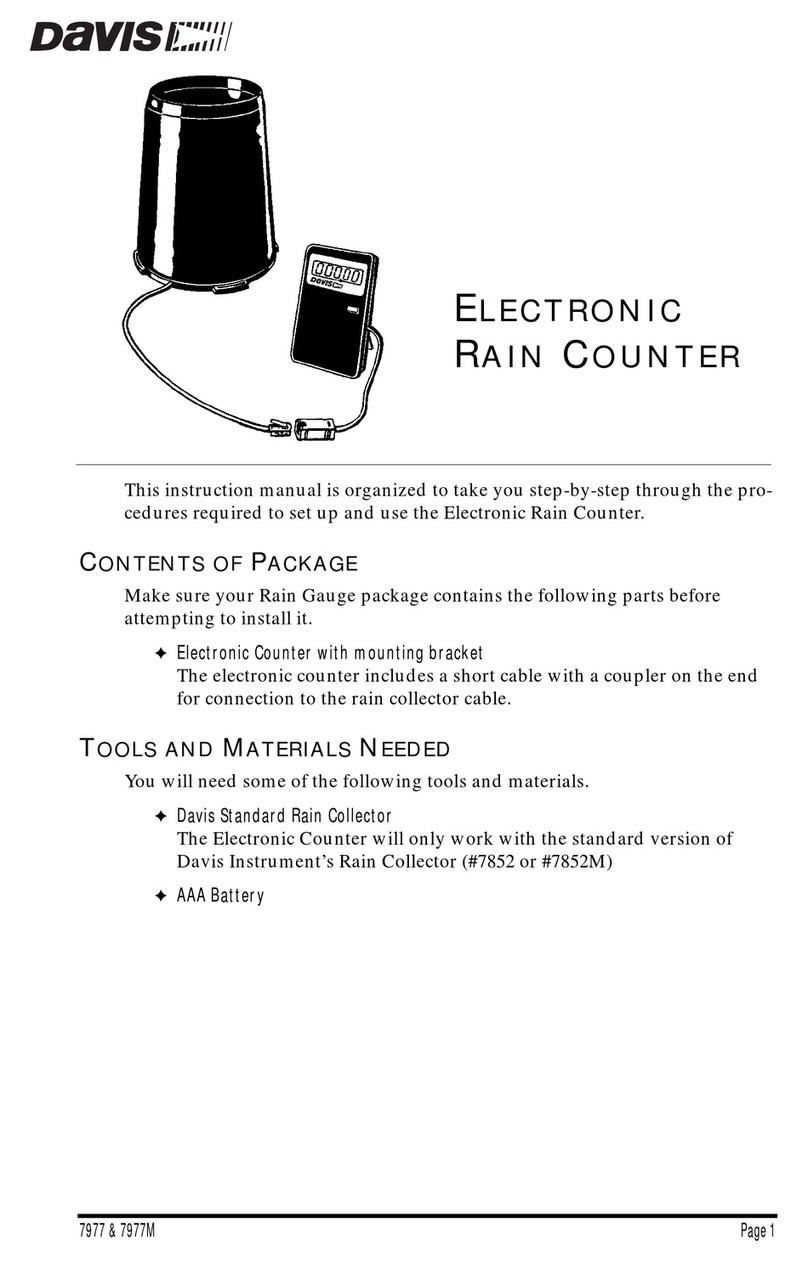
Davis Instruments
Davis Instruments Electronic Rain Counter instruction manual
